It's Garden
Design Time
by
Paula Steers Brown, Contributing Writer
In the
weedless, bugless comfort of your easy chair, take the most essential and
most fun first step in gardening: Design your ideal landscape. Use this
down time to inventory your site, make a practical checklist of your
needs, then a wish list of your most extravagant dreamscape and meet
yourself in the middle with a budget that is divided into the proper
stages to realize your plan.
|
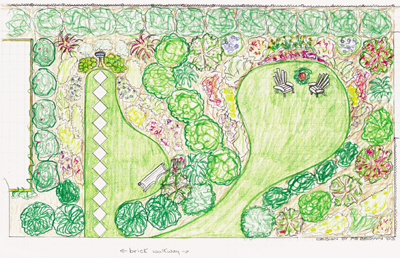
Using
graph paper and a little imagination, you can create a to-scale
sketch of your dream garden. This drawing was the preliminary plan
for the garden pictured below. |
Site
inventory. Take a slow walk around your property and, most
importantly, take a fresh look and record your honest appraisal of its
best features and its worst problems. Let the site speak for itself and
its relation to the environment, and try to listen as if you were Frank
Lloyd Wright. This site inventory should include its orientation to the
sun, views (good and bad, both from the garden and also as framed from
inside the house), slope, drainage, any changes of level, proximity to
neighboring buildings, any sources of noise that may need muffling, large
trees, and any other special features. Take notes and photographs and
sketch a simple drawing of what you see. If house plans are available, all
the measurements of the house and the property lines near the house are
compiled for you; this makes an easy base plan over which tracing paper
can be placed for you to sketch your inventory of positives, negatives,
and the next key step � suggestions for improvement.
|

Create
a panoramic view of your yard by photographing sections and taping
them together. Use a marker to sketch ideas right onto your
photos. |
Site analysis.
Return to a comfortable spot and cogitate with optimism and invention.
This is the time to look at ways to solve problems by seeing your site�s
potential, devising clever ways to minimize your site�s faults and
maximize its assets. For example, a 6-foot shrub planted close to your
personal area can be as effective a visual barrier to create privacy as a
30-foot tree on the property�s edge. The removal of a diseased tree just
might open up a pleasing view of your neighbor�s handsome and healthy
Southern magnolia whose dark green leaves would make the perfect backdrop
for a mixed border of shrubs and perennials without your having to rake
the constantly dropping leathery leaves. Designers call this borrowing
�visual appropriation.� Just remember, a mature tree is the best way
to achieve the goal of having your garden look old and established from
the start. Renowned landscape architect Thomas D. Church reminds us always
to examine the �decorative value of branch structure� in these living
garden sculptures.
|

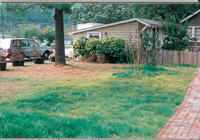
Spring
1997 - New bare fences, unglazed brick, and a grassy
rectangle.

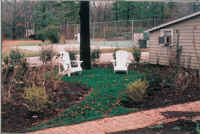
Fall
1997 - Two intimate garden spaces defined.


Spring
1999 - In just two growing seasons, a once-bare lot is
transformed. |
Get
into the Zone. The next step, sometimes called the �bubble plan,�
involves dividing your yard into outdoor zones based on their functions
� areas for entertaining, outdoor dining, work, play, or just reading
the paper. This is an experimental phase, your chance to indulge your most
extreme garden fantasy, so give your imagination free rein. For a quick
thrill, overlay a photograph of that nice level area in the side yard with
tracing paper and dash off a garden whim per page as if you had just won
the lottery � here an outdoor shower swathed in fragrant vines, there a
lavender walk to a picket-fenced Colonial herb garden. Even if the concept
is not used, some part of it may be adapted. There may not be room or sun
enough for a geometric herb garden with brick paths, but an artful
grouping of attractive pots filled with culinary herbs on the deck near
the kitchen door may be plenty serviceable for cooking. A total Zen garden
may be rejected in favor of a quiet, meditative corner with a comfortable
seat in close proximity to a stone sculpture or small pool of stirring
water.
|
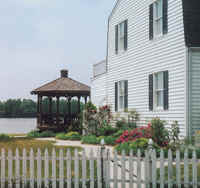
This
undulating sidewalk creates an interesting visual pattern that
simultaneously edges perennials and provides a very practical
mowing strip, cutting down on maintenance. |
Functions
and junctions. Bring all family members into the act at this bubble
stage and be sure to take into account any very young or canine members
who may not have voiced their opinions on all the possible uses for
outdoor space. List desired site uses in order of importance and the
requirements of each. For example, roses and vegetables need full sun.
Outdoor dining needs to be close to the kitchen on a hard, level surface
with some shade and privacy from neighbors and the street. The size of
each area is determined from its priority ranking, the number of people
using it, and the space available. It is best to plan related functions as
a unit such as the driveway, walkway, and porch entry with the important
�psychology of arrival� in mind, being visually open and welcoming.
Consider placing steps further out from the door to make a more spacious
landing area, lending a generous feel of graciousness to the guests�
arrival experience. Of course, utility areas such as the trash, storage,
wood pile, compost pile, or potting shed should also be related and
removed from public view and living areas. Try to relate outdoor functions
to their indoor counterpart: wood to the fireplace, herbs to the kitchen
sink, play area within view of the kitchen window and near the mud room.
|
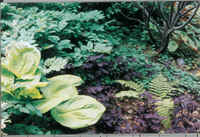
Foliage
color is around a much longer time than bloom. Combinations such
as the purple and chartreuse of these leaves punch each other out. |
You
will need to think about the best traffic patterns within the garden in
relation to the priority of the zones, and some rerouting may be
necessary. A long main axis is visually strong, the garden walk itself
serving as one of the chief design features while also functioning as a
divider to various garden �rooms.� An axis also presents an
opportunity to highlight an impressive focal point at its termination. A
stone walkway flush with the edge of a perennial border serves as an
aesthetically beautiful yet practical mowing strip, greatly reducing
maintenance. On walkways you travel often, close-up views of the details
of delicate blossoms and the various stages of bloom can be appreciated
even on the smallest plants, so decide which of your favorite plants
appeal to all the senses and use them appropriately, leaving large drifts
of mass plantings for distant views. Steps connecting paths on different
levels should be ample, comfortable, and located so as to entice one�s
passage on them. The classic formula is: twice the riser plus the tread
should equal 26 inches (as in 6-inch risers with 14-inch tread or 4-inch
risers with 18-inch tread; a 1/8- to 1/4-inch fractional pitch should be
included to shed water).
|
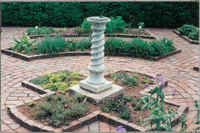
Paving
such as these brick paths in the herb garden at Maymount in
Richmond separate the garden into manageable beds, raised to
promote good drainage, while also creating an aesthetically
beautiful design. |
Practical
matters. Having given thought to the functions your ideal outdoor
space would serve, now consider practical budget concerns such as the cost
of grading, retaining walls, paving, lighting, irrigation, soil
improvement, any outdoor structures (trellises, decks, benches, swings,
arbors, pergolas, fences), or garden ornaments (statuary, fountains,
architectural objects, birdhouses, feeders, and baths). Sometimes
structures can perform double duty. Outlining a deck with benches takes
the place of railings while providing seating enough for any party. A
narrow retaining wall can become more useful by adding a cap wide enough
to sit on (18 inches is comfortable). Orient structures so they are
protected from winter winds, but can catch as much summer breeze as
possible to extend the time they can be enjoyed. Remember enriching your
soil and correcting any drainage problems are of paramount importance.
Before digging, call the utility companies and, if possible, get them to
mark a mechanical plan for your file showing electric lines, phone lines,
gas and sewer lines.
Maintenance is an ongoing practical consideration for
any garden design. Do you intend to do all your own lawn care and weeding
or hire someone to help? If you are your own yard man, do not bite off
more than you can chew by planting perennials that have to be frequently
weeded and pruned. Plant only what you can �say grace over.� A tiny
corner you pass by often that is packed with constant bloom and fragrance
and provides a habitat for a bird family you can observe at close
proximity can bring more joy than palatial borders endlessly in need of
attention. Can you deal with the tangle of a full-blown cottage garden or
are you a neat and tidy sort who likes to see mulch setting off each
clump? If you are the latter, plant only peonies and poppies or stick to
evergreen shrubs. Most perennials multiply greatly, giving you a huge
return on your initial investment that most people appreciate; however, it
is best to avoid vigorous spreaders (or bury them in a pot to contain
their growth) if you do not have the heart to dig up faster-growing plants
that overtake the slow ones. Planting perennials close together (12 inches
apart or less) has several advantages: 1) the garden will have a full and
exuberant look sooner; 2) plants literally support each other without
staking; and 3) thick, healthy plants discourage weeds and require less
mulch. If you are a patient and frugal gardener, though, plant fewer
perennials at the beginning and use your divisions to start new beds.
Obtain a good book on the care of perennials to get the best performance
out of your plants. I recommend The
Well-Tended Perennial Garden by Tracy DiSabato-Aust.
Plant
selection. Clearly one of the most exciting steps is actually picking
out the plants for your dream garden. Yet remembering to operate within
good design constraints in this step can also make it one of the most
daunting. A designer must think in so many dimensions at once: height,
width, depth, time (for succession of bloom) and try to achieve successful
flower and foliage color combinations, as well as a desirable contrast in
their form and texture. In selecting plants, keep in mind the amount of
available light, soil type, and moisture content. Also, try to project
your garden over time. A �Nellie Stevens� holly�s lovely pyramid
shape perfectly punctuates each corner of your home�s new foundation
when small, but in 10 years, the 25-foot tree will have consumed your
house (if the mildew from lack of air circulation behind it did not rot it
first). Usually, the more established your landscape becomes, the shadier
it gets, so remember to sprinkle in more whites and yellows to brighten
shade areas as the garden ages.
If you have any special months when you entertain
annually, gauge your bloom time to the event: my Kentucky Derby party
would feature peonies, late tulips, and regal iris. If you are fortunate
enough to have a pool, plant crape myrtle, grasses, sedum, and tropical
cannas for garden lushness at your pool party in the sizzling heat of
summer. An Oktoberfest where steins are raised around an outdoor fireplace
or freestanding Mexican chiminea could be further warmed by blazing orange
pyracantha trained against the patio wall or by harvest gold
chrysanthemums. Since perennials� bloom time can be fleeting, force
yourself to design more with foliage in mind � it lasts either three
seasons or is evergreen. Grow extra annuals in pots so you will have them
to plant (pot and all) to fill in spaces where color is needed.
Rules of (a
green) thumb. A cardinal rule of design is to repeat the plant itself
or its color in bloom or foliage throughout the garden for unity and
cohesiveness. In my front yard, a fountain of vibrant yellow spills from
my huge forsythia, sunny pansies echo the vivid color in pots and
windowboxes, and golden King Alfred daffodils trumpet springtime. Another
good maxim is to choose one plant that has both good foliage substance and
a splashy display of bloom to showcase each month. Azaleas and dogwoods
dapple April; voluptuous peonies perfume May; roses reign supreme in June;
Oriental lilies, daylilies, and black-eyed Susans bridge the early summer
gap; hydrangeas� blue and white mopheads cool off July; butterfly bush,
phlox, and hardy hibiscus thrive in August; asters, dahlias, and mature
annuals like celosia, cosmos, and cleome fill out September and October;
berries of nandina, holly, ligustrum, and mahonia speckle the set of the
winter stage.
Careful thought about all the things we want to do
with the landscape leads us to discover all a garden can bring to our
lives. Our efforts add great value to our property and bring balance to
our indoor existence, harmony to our souls. Pull out the best garden
implement of the season � a pencil � put it to paper, and get ready to
reap the results.
�
Paula Brown is a freelance writer and lecturer on gardening topics. She
lives in Richmond, Virginia, where she runs her design business, Imagine
That. Questions, comments? E-mail her at [email protected].